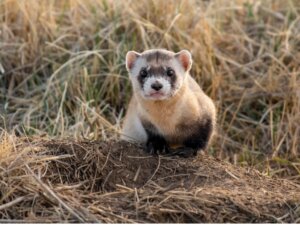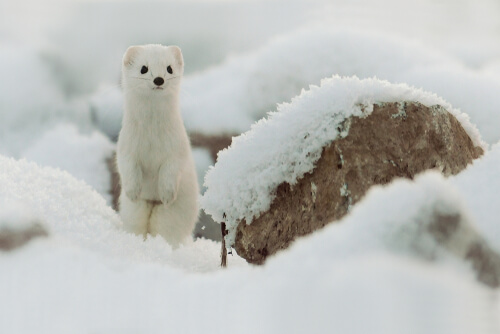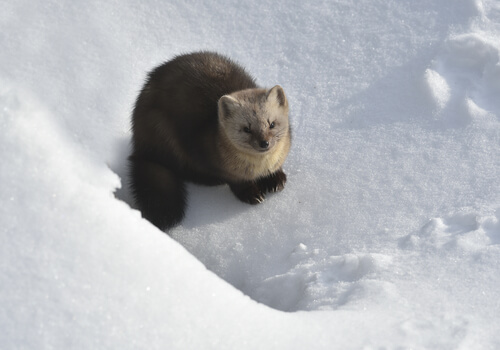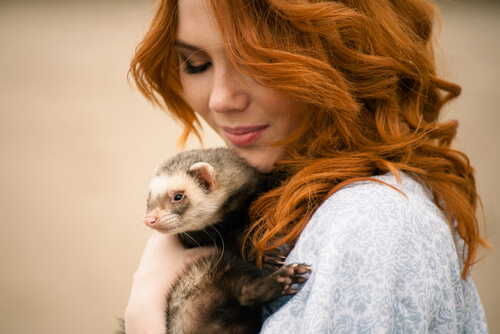The Mustelids: Animals Worn by Kings but Despised for Their Smell


Written and verified by the vet Érica Terrón González
The mustelids are a very active group of small animals, most of them carnivores or scavengers. They have been hunted for generations for their long body covered with dense, fine fur. But they’re also despised because many of them are endowed with scent glands that give off a very unpleasant odor.
The mustelids that are most coveted for their fur
Within the mustelids (the Mustelidae family), three types of animals can be distinguished:
- Those with bare soles, such as the badger.
- Those with hairy soles, like the marten.
- Those with webbed feet, like the otter.
The American mink
Neovison vision, the American mink, is a close relative of the weasel, but, unlike the weasel, it’s highly sought after by the fur industry. It digs its burrows near water, where it feeds on fish, frogs, reptiles and rodents. It sometimes attacks birds if it’s very hungry. But, unlike the weasel and the marten, it only kills if it needs to.
Its fur turns white in winter, like that of the stoat, making it even more valuable.

Native to North America, its natural range occupies most of the United States and Canada. The problem comes because it has been imported to fur farms in the rest of the northern hemisphere. As a result, many specimens have managed to escape from these farms, entering the wild.
Its presence in Europe is undesirable, as it displaces native mustelid species, already seriously endangered, such as the European mink.
The stoat
Mustela erminea has also always been highly coveted for its soft, high-quality fur, from which coats were made. Today, farmed mink fur has largely replaced ermine fur.
In summer, its fur is brown or brown on the back and whitish on the chest and belly. In winter, in the mountains and in colder regions, it becomes completely white in order to camouflage itself. But it always retains some black at the end of its long tail, which is a good way of identifying it.

The marten
Martens are common in almost all of Europe, as well as in some areas of the Middle East. They’re characterized by a thick, soft, dark brown coat on almost their entire body, except on the underside of the neck and belly. In these areas, their fur has a yellowish cream color, which is why its fur is so highly prized.
The sable, Martes zibellina, is a subspecies of the common marten that today is rather widespread on the Asian continent. It’s one of the most valuable fur species, especially when its fur is black.

The purest black among the skin types of the sable is called “black diamond”.
Why haven’t the mustelids won us over?
This is probably due to the “smelliest” representatives of this family: the skunks. For example, the striped skunk, Mephitis mephitis, is noted for its beautiful, bushy tail. But under its tail is its greatest defensive weapon: the most developed anal glands in the entire mustelid family. With them, it manages to expel a foul-smelling liquid with a pungent odor that can be perceived in a radius of more than a kilometer.
Its odor is so strong that it impregnates the objects it reaches for several weeks. And if it reaches the eyes, it’s capable of causing temporary blindness in humans.
The pygmy spotted skunk, Spilogale pygmaea, on the other hand, is very adept at spraying its stinking liquid. It makes a sort of vertical line, resting on its forelimbs, and sprays its opponent.
Despite initial reluctance, we now enjoy them as pets

The ferret, Mustela putorius furo, is a subspecies of the wild polecat that was domesticated thousands of years ago. At first, it was used to collect rabbits in the field without the use of weapons. But, over the years, it became a pet. And the bad odor given off by its body glands hasn’t managed to be an impediment.
All cited sources were thoroughly reviewed by our team to ensure their quality, reliability, currency, and validity. The bibliography of this article was considered reliable and of academic or scientific accuracy.
- Mustelidae [Internet]. Es.wikipedia.org. [cited 28 May 2020]. Available from: https://es.wikipedia.org/wiki/Mustelidae
- Mephitis mephitis [Internet]. Es.wikipedia.org. [cited 28 May 2020]. Available from: https://es.wikipedia.org/wiki/Mephitis_mephitis#:~:text=La%20mofeta%20rayada%20o%20listada,estados%20del%20norte%20de%20M%C3%A9xico.
- Mustela erminea [Internet]. Es.wikipedia.org. [cited 28 May 2020]. Available from: https://es.wikipedia.org/wiki/Mustela_erminea
- Martes martes [Internet]. Es.wikipedia.org. [cited 28 May 2020]. Available from: https://es.wikipedia.org/wiki/Martes_martes
- Neovison vison [Internet]. Es.wikipedia.org. [cited 28 May 2020]. Available from: https://es.wikipedia.org/wiki/Neovison_vison
- Pérez Más E. Mamíferos. [Barcelona]: Bruguera; 1978.
This text is provided for informational purposes only and does not replace consultation with a professional. If in doubt, consult your specialist.